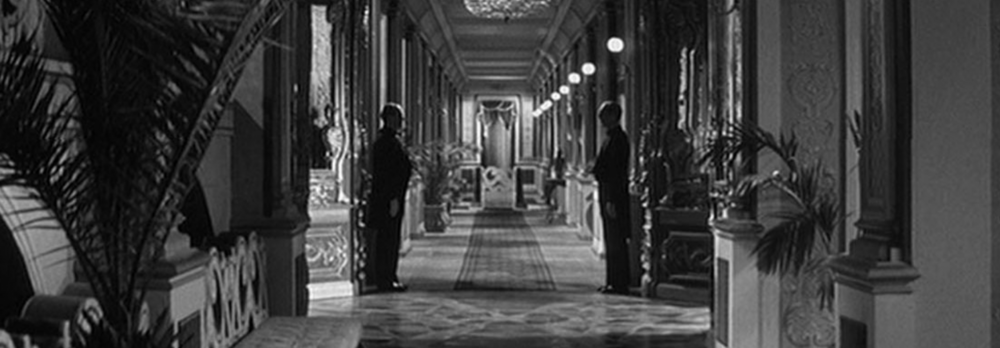Film Notes: LAST YEAR AT MARIENBAD

LAST YEAR AT MARIENBAD
7 p.m. Sunday, February 7, 2016
53 Wall Street Auditorium
Introduction and Film Notes by Brian Meacham
PDF
Directed by Alain Resnais (1961) 94 mins
Written by Alain Robbe-Grillet
Produced by Pierre Corau, Anatole Dauman, and Raymond Froment
Distributed by Cocinor
Starring Delphine Seyrig, Giorgio Albertazzi, Sacho Pitoëff, and Françoise Bertin
Described by critic Geoffrey Nowell-Smith in 1962 as “a revolutionary kind of cinematic spectacle” and by Pauline Kael in 1963 as a “high-fashion experimental film, the snow-job at the ice palace,” LAST YEAR AT MARIENBAD has been electrifying and infuriating critics and audiences for more than 50 years. The film, which nominally tells the story of two unnamed people who wander the hallways, drawing rooms, and immacuate grounds of a country estate, trying to work out where and when they may have met before, defies explanation and resists conventional interpretations of chronology, motive, and action. In the words of its director Alain Resnais, “Make of it what you will...whatever you decide is right.”
THE FILMMAKERS: Alain Resnais was already an award-winning documentary filmmaker when he made his debut narrative film, HIROSHIMA MON AMOUR, written by Marguerite Duras, in 1959. When the film was released to rapturous critical and commercial acclaim (and an Academy Award nomination for Duras), Resnais’ producers approached the leading light of the nouveau roman movement, novelist Alain Robbe-Grillet, with an offer for the two men, born a few weeks apart in the summer of 1922, to collaborate on a film project.
Robbe-Grillet returned with four script outlines, and Resnais agreed to film any one of them. They shortly settled on L’année dernière à Marienbad, and Robbe-Grillet began working on the script. The two men were in agreement about how to approach the story; they shared a desire to construct what Robbe-Grillet called “...a purely mental space and time--those of dreams, perhaps, or of memory, those of any affective life--without worrying too much about the traditional relations of cause and effect, or about an absolute time sequence in the narrative.” By the time he had completed his script, he was able to provide Resnais with not only dialogue but an account of each shot in the film as Robbe-Grillet imagined it, including descriptions of camera movements and editing techniques. The filmmakers collaborated on the construction of the script, but once filming began, in the winter of 1960-61, Robbe-Grillet stayed away from the set, never once visiting during filming. His reaction to first seeing a rough cut: “I didn’t believe it could be so beautiful.”
THE STYLE: Legendary designer Coco Chanel had worked for film productions in the 1930s, most notably for another (very different) country estate story, THE RULES OF THE GAME, and its director Jean Renoir, in 1939. Her designs for Delphine Seyrig, when combined with Seyrig’s more natural, modern hairstyle, made LAST YEAR AT MARIENBAD a trend-setting film and Seyrig an avant garde style icon, bringing a certain sleek freshness to a world used to teased, beehive hairdos. The film continues to influence today: just last month, designer Marc Jacobs cited Seyrig and the “Marienbad look” as the inspiration for his 2016 fashion collection and its advertising face, Winona Ryder.
DID YOU KNOW: Though he had nothing to do with the making of the film beyond inspiring its filmmakers, Alfred Hitchcock makes one of his signature cameos early on in LAST YEAR AT MARIENBAD. Look for a life-size cutout of the master in profile, seemingly floating at screen right next to an ornate elevator.
Presented in the Treasures from the Yale Film Archive series with support from Paul L. Joskow '70 M.Phil., '72 Ph.D. Printed Film Notes are distributed to the audience before each Treasures screening.